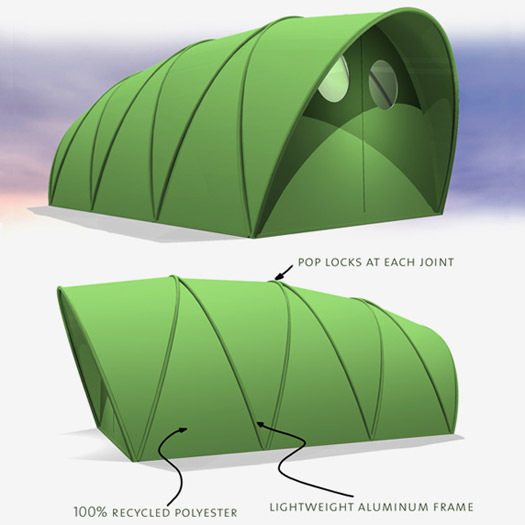 Patrick Wharram's Lightweight Emergency Shelter. Rendering courtesy Design 21: Social Design Network.
Patrick Wharram's Lightweight Emergency Shelter. Rendering courtesy Design 21: Social Design Network.As aid and relief supplies reach Haiti to help earthquake victims, attention is focusing on immediate needs such as food, water, medical care and temporary shelter. Shelter plays a critical role in emergency relief as a way not only to protect victims from weather conditions but also to provide a semblance of family and community life amid horrific conditions and collapsed infrastructure.
For the most part, aid organizations still rely on old standbys like tents and tarps for emergency shelters. They are cheap and easy to transport and set up, and although basic, they work well for immediate shelter even in precarious conditions such as post-earthquake Haiti. “Nothing beats the price point of a blue tarp,” notes Deborah Gans, of Gans Studio, a New York architecture firm that has worked in the area of disaster relief housing.
There are new and innovative alternatives to tarps and tents, which have been developed over the past decade following disasters ranging from the Asian tsunami to Katrina and earthquakes in Pakistan, China and Iran. These designs use new lightweight materials, or sandbags or indigenous materials such as repackaged clay or earth. They also incorporate clever folding and packaging methods.
But the new designs have drawbacks: they are usually more expensive than tarps and tents; they have not been widely field-tested; and they are not kept in inventory in large numbers, which means overwhelmed aid agencies can’t rely on a rapid deployment. Moreover, while the newer designs can be used for prompt emergency housing they are often better suited for the second stage of relief known as transitional housing, between emergency shelters and permanent settlement.

Steps for setting up Concrete Canvas Shelter. Photos courtesy Concrete Canvas.
Compared to soft solutions like tarps and tents, the recently launched Concrete Canvas Shelters — rapidly deployable hardened shelters made from a cement-impregnated fabric — are robust and solid structures that can be erected in a few hours (all you need is water and a generator for the air pump). But they cost around $24,500 for a 270-square-foot unit, and because it is a new technology, developed by the British company Concrete Canvas, supplies are limited. Originally developed for military use and as field hospitals, concrete shelters are “probably not appropriate for Haiti as short term housing but as a replacement for infrastructure, such as for hospitals and field operations,” explains Peter Brewin, the company’s operations manager.

Concrete canvas shelters are not as expensive as the notorious FEMA trailer, used for years after Katrina to house the displaced, which cost around $67,000 each. A less expensive way to go might be Gans’s Roll Out House, made of two infrastructural columns, one of folded paper and one of bamboo, which support a roof that collects water and is equipped with photovoltaic cells. The core house could be delivered for “several hundred dollars,” Gans says, but the design, originally developed for Kosovo refugees, has never been put into production.
Prefab structures, like Global Village Shelters, are another option. These are solid, waterproof structures are made of extruded polypropylene and shipped as flat packs. Small 65-square-foot units cost around $1,000 when ordered in bulk, but they take up to eight weeks to manufacture. Still, Dan Ferrara, founder of Global Village Shelters, says one benefit of these shelters over tents is that their sturdiness “provides a sense of home.”

Global Village Shelters. Photo courtesy Global Village Shelters.

Global Village Shelters. Photo courtesy Global Village Shelters.
Patrick Wharram’s Lightweight Emergency Shelter, which won first prize in a competition on the design for social change site Design21, is easy to transport and erect and has a sustainable element — it’s made of recyclable polyester mesh and aluminum, so it can be reused or recycled when the emergency is over. What’s more, the foldable framework and polyester material are sewn together to form a single unit. That means no loose components that could get lost; setup is easy. “The whole shelter is one piece that concertinas out from its packed state and locks into rigid form,” Wharram, a freelance designer, explains. “In a natural disaster like in Haiti, the last thing rescue workers or locals need to be concerned with is erecting a shelter that is complicated to assemble.”
Unfortunately, the Lightweight Emergency Shelter is not yet in production (a prototype is expected this year). That’s too late to help the people of Haiti, who will have to make do right now with tarps and tents as their temporary homes as they start to rebuild their lives.
Unfortunately, the Lightweight Emergency Shelter is not yet in production (a prototype is expected this year). That’s too late to help the people of Haiti, who will have to make do right now with tarps and tents as their temporary homes as they start to rebuild their lives.


Comments [29]
01.19.10
01:40
Have any of these options been deployed? Have any NGO's, and/or governmental organizations been serious about listening to the design community? Conversely have designers been listening to aid organizations to reduce costs, manufacturing processes' and delivery systems? Just curious if anyone has any information about test cases to put anything like the options discussed into use.
Thanks.
01.19.10
03:55
My personal experience over the past 5 years since Katrina has boiled down to several key findings or hard lessons learned by a designer:
1. You can not design for the "greater good" and expect it to go anywhere on merit alone. The "greater good" is broke. That is to say, you can not just solve the problem and expect it to go anywhere with a solid business case and profit projections – no matter how brilliant the solution is.
2. Solutions for promotion vs. real solutions over the years has also been an issue. Mark, you are right there have been tons of solutions since Katrina around housing and virtually none have been built. I would like to propose that the majority of them were not serious attempts to solve the problem but as an exercise within design/architecture studios which where then submitted to every design publication for promotion. This effectively created a wall of noise making it hard for the legitimate solutions to be filtered out of this. This makes marketing a solution very difficult - especially if you are an individual. My system really only got traction once I joined frog design and they attached their name to it. My housing solution coming from this one designer that no one has ever heard of, made it extremely hard to compete for headlines against staritects and their brain farts. Core77 has turned me down because my solutions was not "fresh" meaning housing systems by designers have been covered already.
3. The government views housing as "insurance". I have literally been told by one senator's chief of staff that "son, you better hope for another hurricane to roll in, because you are just selling insurance".
4. Most aid organizations and NGO's do not develop products. They do not offer grants to have products developed. They only procure supplies and run inventories of those supplies. Housing system components (even tent like options) take up a lot more shelf space than MREs. So, this leaves it back up to individuals to bet the farm so to speak on their solution and develop it with the hope that NGO's will have the budget to buy it so they can recoup their expenses (not talking profits here).
5. Existing manufactures that could easy step laterally into selling housing systems for disaster relief need strong business cases, market research, and profit projections. The manufactures I have talked to expect the designer to bring all of that home work with them. So, not only do you have to solve the problem, you have to get your hands dirty as to how someone else will make massive profits from your idea. It gets to be a dirty feeling, at least for me, at this point when your original goal was only to those in need.
I go on and on but I am jaded and tired. I hope this helps clarify Mark. As for talking with NGOs in regards to their needs - have you ever tried to set up a meeting like that? Believe me as an unknown designer, no one calls back or puts you through to the person with the calendar.
-michael
01.20.10
10:56
Thank you so much for taking the time to respond. I know it must have been hard to restrain yourself in recounting your frustrations in attempting to bring real world solutions to the fantasy world of design and architecture for the greater good. I truly appreciate your struggles and the problems that you laid out here. It is pretty much as I suspected as an outsider in product design, when it comes to aid organizations, manufacturers and government. Unfortunately the saddest indictment that you make is in your assessment of promotion v. solution, "See how clever we are, see how much we care, see how fast we are moving on to a featured spot at the TED conference.
Thanks again for your attempt to transcend this insurmountable problem. I only wish that a design conference somewhere would invite you to speak on this side of the issue of Design for the Greater Good.
Cheers.
01.20.10
04:28
You are missing one of the most promising temporary housing designs of the decade: check out the Reaction system, by designer Michael McDaniel; http://www.protectthehuman.com/videos/reaction-housing
Best Wishes,
Robert
01.21.10
12:44
Michael was gracious enough to relate his story in the comment above mine.
01.22.10
07:58
01.24.10
09:40
What kind of material(s) were used to fabricate the EXO? Looking at your design makes me wonder about the ventilation and VOC's. I'm sure you've consider all this, but I was curious. I think the concept is great. I like the reference to IKEA in your video. Everything needs to be modular and flexible in adapting to a disaster environment. With all the military bases that have closed over the years, I would think most cities, counties and states with programs implemented for Emergency Preparedness like the San Francisco Bay Area could utilized these bases for storage.
02.22.10
03:10
06.29.10
02:43
critical care jobs
07.09.10
03:39
08.31.10
06:31
12.15.10
09:06
03.01.11
10:52
04.13.11
08:38
Linda Wilburn
My travel blog - Golf Resorts
04.17.11
01:55
acid alkaline diet review
04.22.11
03:29
love quotes
watch free movies online
04.22.11
07:17
wine bar brooklyn
10.05.11
08:23
03.02.12
06:27
03.15.12
07:07
outback coupons
03.28.12
05:45
03.29.12
03:15
04.26.12
01:31
05.10.12
07:27
05.16.12
07:05
05.22.12
02:19
05.22.12
07:30
06.08.12
01:29
09.05.12
05:14